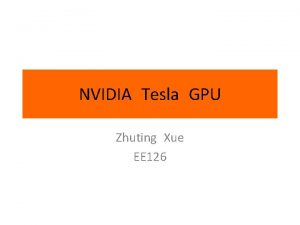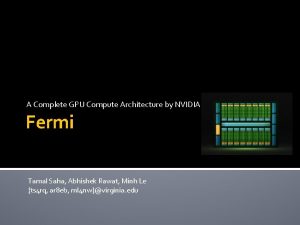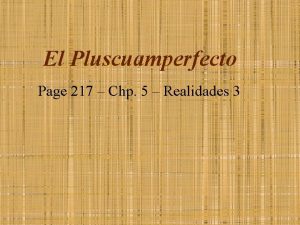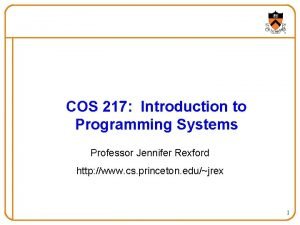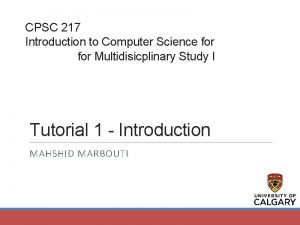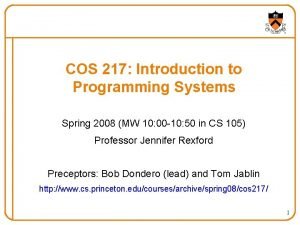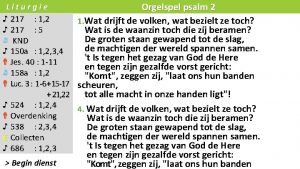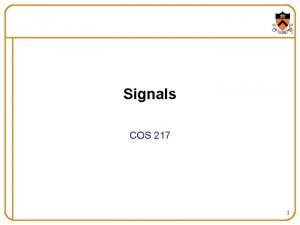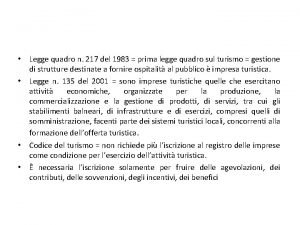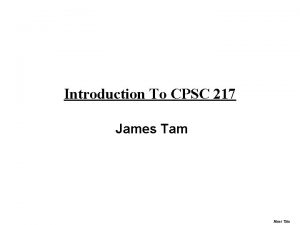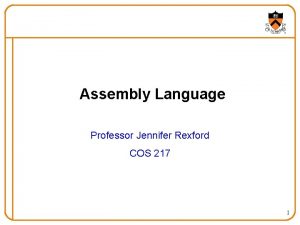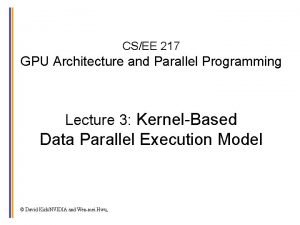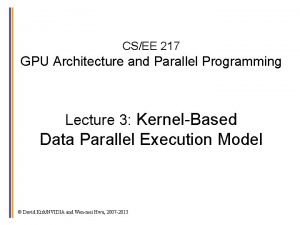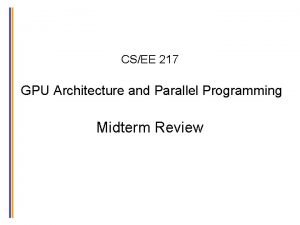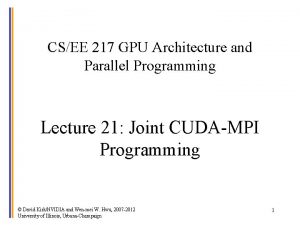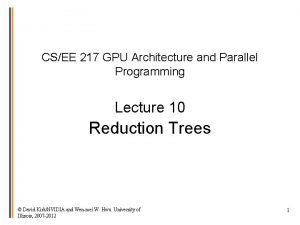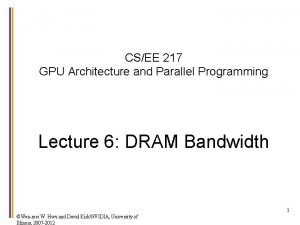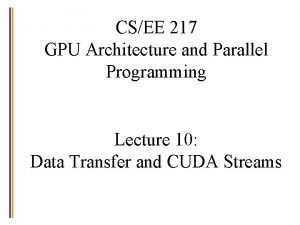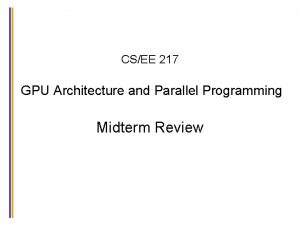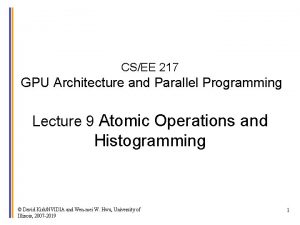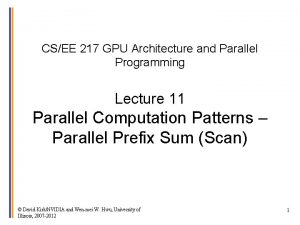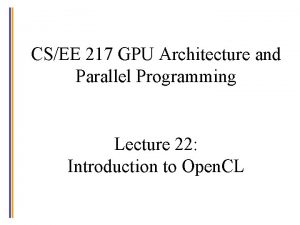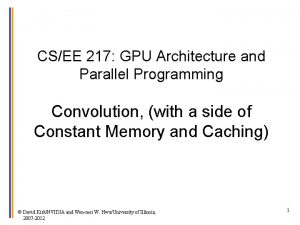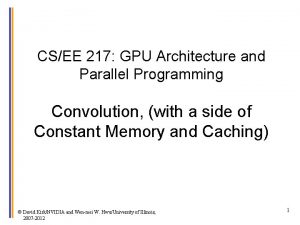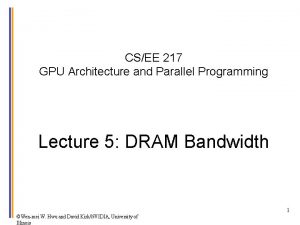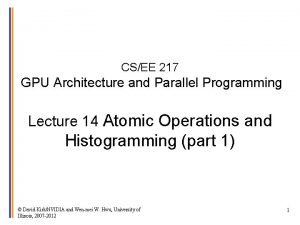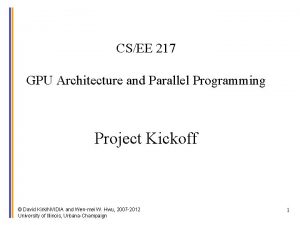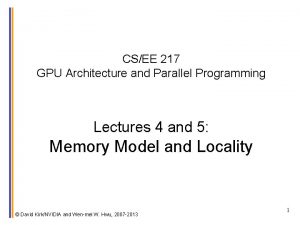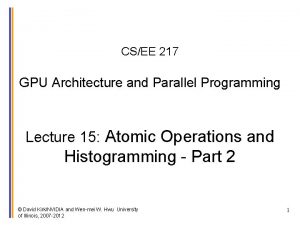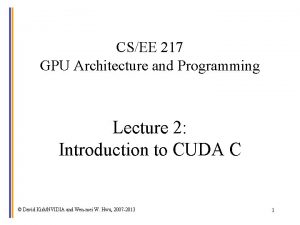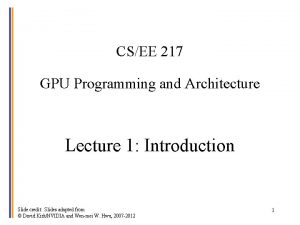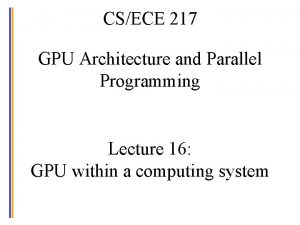CSEE 217 GPU Architecture and Parallel Programming Tiled








![Ghost Cells N 0 0 N[0] N[1] N[2] N[3] N[4] N[5] N[6] 0 0 Ghost Cells N 0 0 N[0] N[1] N[2] N[3] N[4] N[5] N[6] 0 0](https://slidetodoc.com/presentation_image_h/dbd2ed52ee07887f6439770770036079/image-9.jpg)

















- Slides: 26

CS/EE 217: GPU Architecture and Parallel Programming Tiled Convolution © David Kirk/NVIDIA and Wen-mei W. Hwu University of Illinois, 2007 -2012 1

Objective • To learn about tiled convolution algorithms – Some intricate aspects of tiling algorithms – Output tiles versus input tiles 2

Tiled 1 D Convolution Basic Idea P 0 1 2 3 4 5 6 7 8 9 10 11 12 13 14 15 N Tile 0 ghost 0 1 2 3 4 5 Tile 1 2 3 4 5 6 7 8 9 Tile 2 6 7 8 9 10 11 12 13 Tile 3 10 11 12 13 14 15 halo ghost 3

Loading the left halo n=2 N 0 1 2 3 4 5 halo_index_left = 2 N_ds 2 3 4 5 6 7 8 9 10 11 12 13 14 15 i =6 6 int n = Mask_Width/2; int halo_index_left = (block. Idx. x - 1)*block. Dim. x + thread. Idx. x; if (thread. Idx. x >= block. Dim. x - n) { N_ds[thread. Idx. x - (block. Dim. x - n)] = (halo_index_left < 0) ? 0 : N[halo_index_left]; } 4

Loading the internal elements n=2 N 0 1 N_ds 2 3 4 5 halo = 2 2 3 6 7 8 9 10 11 12 13 14 15 i =6 4 5 6 N_ds[n + thread. Idx. x] = N[block. Idx. x*block. Dim. x + thread. Idx. x]; 5

Loading the right halo n=2 N 0 1 2 3 4 5 6 7 8 9 2 3 4 5 6 11 12 13 14 15 halo_index_right = 10 i =6 N_ds 10 7 8 9 int halo_index_right = (block. Idx. x + 1)*block. Dim. x + thread. Idx. x; if (thread. Idx. x < n) { N_ds[n + block. Dim. x + thread. Idx. x] = (halo_index_right >= Width) ? 0 : N[halo_index_right]; } 6

__global__ void convolution_1 D_basic_kernel(float *N, float *P, int Mask_Width, int Width) { int i = block. Idx. x*block. Dim. x + thread. Idx. x; __shared__ float N_ds[TILE_SIZE + MAX_MASK_WIDTH - 1]; int n = Mask_Width/2; int halo_index_left = (block. Idx. x - 1)*block. Dim. x + thread. Idx. x; if (thread. Idx. x >= block. Dim. x - n) { N_ds[thread. Idx. x - (block. Dim. x - n)] = (halo_index_left < 0) ? 0 : N[halo_index_left]; } N_ds[n + thread. Idx. x] = N[block. Idx. x*block. Dim. x + thread. Idx. x]; int halo_index_right = (block. Idx. x + 1)*block. Dim. x + thread. Idx. x; if (thread. Idx. x < n) { N_ds[n + block. Dim. x + thread. Idx. x] = (halo_index_right >= Width) ? 0 : N[halo_index_right]; } __syncthreads(); float Pvalue = 0; for(int j = 0; j < Mask_Width; j++) { Pvalue += N_ds[thread. Idx. x + j]*M[j]; } P[i] = Pvalue; 7

Shared Memory Data Reuse N_ds 2 • • 3 4 5 6 7 8 9 Mask_Width is 5 Element 2 is used by thread 4 (1 X) Element 3 is used by threads 4, 5 (2 X) Element 4 is used by threads 4, 5, 6 (3 X) Element 5 is used by threads 4, 5, 6, 7 (4 X) Element 6 is used by threads 4, 5, 6, 7 (4 X) Element 7 is used by threads 5, 6, 7 (3 X) Element 8 is used by threads 6, 7 (2 X) Element 9 is used by thread 7 (1 X) 8
![Ghost Cells N 0 0 N0 N1 N2 N3 N4 N5 N6 0 0 Ghost Cells N 0 0 N[0] N[1] N[2] N[3] N[4] N[5] N[6] 0 0](https://slidetodoc.com/presentation_image_h/dbd2ed52ee07887f6439770770036079/image-9.jpg)
Ghost Cells N 0 0 N[0] N[1] N[2] N[3] N[4] N[5] N[6] 0 0 P[0] P[1] P[2] P[3] P[4] P[5] P[6] 9

__global__ void convolution_1 D_basic_kernel(float *N, float *P, int Mask_Width, int Width) { int i = block. Idx. x*block. Dim. x + thread. Idx. x; __shared__ float N_ds[TILE_SIZE]; N_ds[thread. Idx. x] = N[i]; __syncthreads(); int This_tile_start_point = block. Idx. x * block. Dim. x; int Next_tile_start_point = (block. Idx. x + 1) * block. Dim. x; int N_start_point = i - (Mask_Width/2); float Pvalue = 0; for (int j = 0; j < Mask_Width; j ++) { int N_index = N_start_point + j; if (N_index >= 0 && N_index < Width) { if ((N_index >= This_tile_start_point) && (N_index < Next_tile_start_point)) { Value += N_ds[thread. Idx. x+j-(Mask_Width/2)]*M[j]; } else { Pvalue += N[N_index] * M[j]; } } } P[i] = Pvalue; } 10

2 D convolution with Tiling P • Use a thread block to calculate a tile of P – Thread Block size determined by the TILE_SIZE 11

Tiling N • Each element in the tile is used in calculating up to MASK_SIZE * MASK_SIZE P elements (all elements in the tile) 3 4 5 6 7 2 1 2 0 3 2 3 1 4 3 5 1 5 4 6 3 6 5 7 1 2 0 2 1 2 0 3 2 3 1 4 3 5 1 5 4 6 3 6 5 7 1 3 2 1 2 0 4 3 2 3 1 5 4 3 5 1 6 5 4 6 3 7 6 5 7 1 3 2 3 1 3 2 1 2 0 4 3 5 1 4 3 2 3 1 5 4 6 3 5 4 3 5 1 6 5 7 1 6 5 4 6 3 7 6 5 7 1 12

High-Level Tiling Strategy • Load a tile of N into shared memory (SM) – All threads participate in loading – A subset of threads then use each N element in SM TILE_SIZE KERNEL_SIZE 13

Output Tiling and Thread Index (P) • Use a thread block to calculate a tile of P row_o = block. Idx. y*TILE_SIZE + ty; – Each output tile is of TILE_SIZE for both x and y col_o = block. Idx. x * TILE_SIZE + tx; 14

Input tiles need to be larger than output tiles. 3 2 1 2 0 4 3 2 3 1 5 4 3 5 1 6 5 4 6 3 7 6 5 7 1 Input Tile Output Tile 3 2 1 2 0 4 3 2 3 1 5 4 3 5 1 6 5 4 6 3 7 6 5 7 1 15

Dealing with Mismatch • Use a thread block that matches input tile – Each thread loads one element of the input tile – Some threads do not participate in calculating output • There will be if statements and control divergence 16

Setting up blocks #define O_TILE_WIDTH 12 #define BLOCK_WIDTH (O_TILE_WIDTH + 4) dim 3 dim. Block (BLOCK_WIDTH, BLOCK_WIDTH); dim 3 dim. Grid ((image. Width – 1)/O_TILE_WIDTH + 1, (image. Height-1)/O_TILE_WIDTH+1, 1); • In general, block width = Tile width + mask width – 1; 17

Using constant memory for mask • Since mask is used by all threads and not modified: – All threads in a warp access the same locations at every time – Take advantage of the cachable constant memory! – Magnify memory bandwidth without consuming shared memory • Syntax: __global__ void convolution_2 D_kernel (float *P, *float N, height, width, channels, const float __restrict__ *M) { 18

Shifting from output coordinates to input coordinates Input tile for thread (0, 0) Output tile for thread (0, 0) 19

Shifting from output coordinates to input coordinate int tx = thread. Idx. x; int ty = thread. Idx. y; int row_o = block. Idx. y * TILE_SIZE + ty; int col_o = block. Idx. x * TILE_SIZE + tx; int row_i = row_o - 2; //MASK_SIZE/2 int col_i = col_o - 2; //MASK_SIZE/2 20

Threads that loads halos outside N should return 0. 0 21

Taking Care of Boundaries float output = 0. 0 f; if((row_i >= 0) && (row_i < N. height) && (col_i >= 0) && (col_i < N. width) ) { Ns[ty][tx] = N. elements[row_i*N. width + col_i]; } else{ Ns[ty][tx] = 0. 0 f; } 22

Some threads do not participate in calculating output. if(ty < TILE_SIZE && tx < TILE_SIZE){ for(i = 0; i < MASK_SIZE; i++) { for(j = 0; j < MASK_SIZE; j++) { output += Mc[i][j] * Ns[i+ty][j+tx]; } } 23

Some threads do not write output if(row_o < P. height && col_o < P. width) P. elements[row_o * P. width + col_o] = output; 24

In General • BLOCK_SIZE is limited by the maximum number of threads in a thread block • Input tile sizes could be k*TILE_SIZE + (MASK_SIZE-1) – For 1 D convolution – what is it for 2 D convolution? – By having each thread to calculate k input points (thread coarsening) – k is limited by the shared memory size • MASK_SIZE is decided by application needs 25

ANY MORE QUESTIONS? READ CHAPTER 8 © David Kirk/NVIDIA and Wen-mei W. Hwu. University of Illinois, 2007 -2012 26
 Csee sg ida
Csee sg ida Gpgpu matlab
Gpgpu matlab Githubn
Githubn Tesla ee architecture
Tesla ee architecture Nvidia fermi gpu
Nvidia fermi gpu El pluscuamperfecto p 217
El pluscuamperfecto p 217 Cos217
Cos217 Bio 217
Bio 217 Pengertian pangkat, akar dan logaritma
Pengertian pangkat, akar dan logaritma 30 tac 217
30 tac 217 Cpsc 217
Cpsc 217 49 cfr part 217
49 cfr part 217 Kuo y yasu
Kuo y yasu Cos 217
Cos 217 Wat drijft de volken wat bezielt ze toch
Wat drijft de volken wat bezielt ze toch Signal handler
Signal handler Legge 217/1983
Legge 217/1983 Banco rari 217
Banco rari 217 James tam u of c
James tam u of c Cos 217
Cos 217 Cos217 spring 2021
Cos217 spring 2021 Forces are parallel
Forces are parallel Non parallel sentence
Non parallel sentence What is a parallel sentence
What is a parallel sentence Mary likes hiking swimming and to ride a bicycle
Mary likes hiking swimming and to ride a bicycle What is parallel structure in english
What is parallel structure in english Perbedaan linear programming dan integer programming
Perbedaan linear programming dan integer programming



